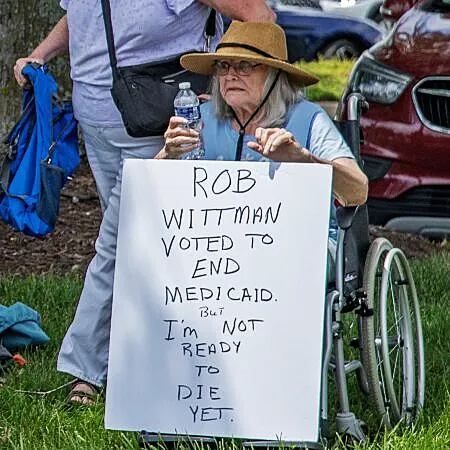
Disabled people with mobility issues often face unique obstacles when attending protests. Mobility aids such as wheelchairs, canes, and walkers mean extra planning is needed in addition to the usual protest preparations.
Whether you’re someone with a mobility issue, a caregiver to someone with a disability, or are learning about this issue for the first time, here are some strategies for navigating a protest while disabled.
Plan ahead
Learn your rights. Read Your Rights as a Protester with a Disability.
Check for accommodations. Contact the protest organizer to tell them your access needs and inquire about accommodations.
Consider attending protests with an able-bodied companion. A companion can clear a path through a crowd, watch for obstructions on the ground, manage any signs or accessories you need to bring, and help with general troubleshooting.
Budget extra time for getting ready. For example, you may need to apply sunscreen or pack rain gear. Depending on traffic and crowd size, you may also need extra time for traveling, parking, and/or walking/rolling to the protest site itself. If there are inaccessible pathways in the protest area, you may need to go the long way around.
Use Google Maps. If the protest site is new to you, Google Maps can provide both a bird’s eye view and a street view of it. Trace the route you’ll need to take from your parking place or bus stop to the site. If applicable, learn the march route ahead of time.
Research the sidewalks. Do they connect with the protest site? Try to learn about rough terrain such as broken pavements, tree roots, or other types of uneven pavements. With sufficient planning, you might discover a more accessible route.
Monitor the weather. This could include strategies like leaving the protest early because of inclement weather; avoiding flood areas; finding tree canopy, or wearing sunblock. Power chair users need to prevent their equipment from getting wet, so packing rain gear is essential if it’s likely to rain.
Transportation strategies
Go early. Allow for plenty of time to find alternative parking or for boarding a bus. Large protests can mean more traffic, which often means longer travel time.
Research parking locations. If you’re traveling by car, Google Maps can help you learn about parking options near the protest. Are there parking lots or just street parking? How congested is the parking in that area? Make a plan to pay for parking if the free options fall through.
Find the accessible parking spots. Accessible parking spaces are often too few, and other drivers will be competing with you for spaces, so plan out several parking space possibilities ahead of time.
For those using wheelchair-accessible vans, make sure the area has accessible spots specifically for vans, and check the height clearance for the entrance as well as the parking decks.
Another option: someone can drop you off at the protest. Plan a pickup site at the end and make an emergency pickup plan.
Budget your energy. Determine how far you can safely travel from your arrival spot to the protest site. Protests are tiring even without a disability in the mix, so budget your labor as well as your time. Maybe you’ll attend for only an hour, and that’s okay.
Safety, aids, and other logistics
Visually communicate your needs. If you don’t have a medical alert or similar identification, buy or create lanyards, jewelry, or other visuals to communicate your condition to others.
Add emergency medical information to your phone. Or make an old-fashioned list.
Take a portable chair. If you have difficulty standing or walking for long periods, a portable chair can help conserve your energy.
Plan for your restroom needs. Ask the protest organizers if accessible portable toilets will be available. Attend with a companion if you need help navigating the restroom. Bring your own portable toilet if possible. Maybe you’ve got a bladder of steel, but it might help to wear absorbent underwear just in case.
Pack your medication. If the protest lasts longer than expected, bring an emergency supply. It’s also ideal to bring evidence of your prescription in the event of a police search.
Bring chargers/batteries. You may or may not be able to charge your assistive equipment, but it’s good to have the option.
Remember: Your safety and health come first. Give yourself permission to not attend a protest. Some are more accessible than others, so focus your time and effort on the easiest ones.
A note for our readers: Heather Massey is the able-bodied parent of a wheelchair user and has experienced the challenging logistics of helping her navigate protests.
Take Action
- Be aware that protest locations can be extra challenging for physically disabled persons. If you see someone who needs help with accessibility at a protest, ask if there is anything you can do to assist.